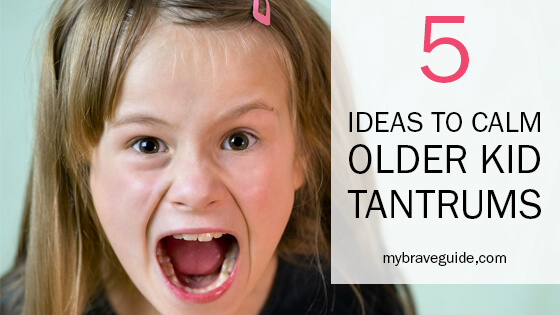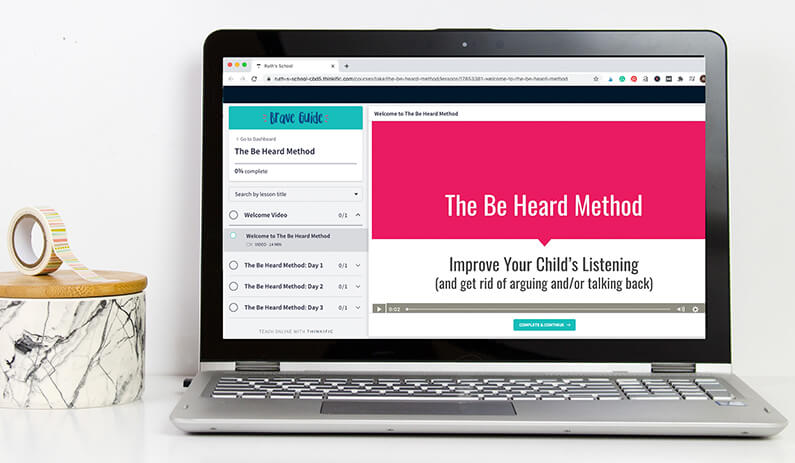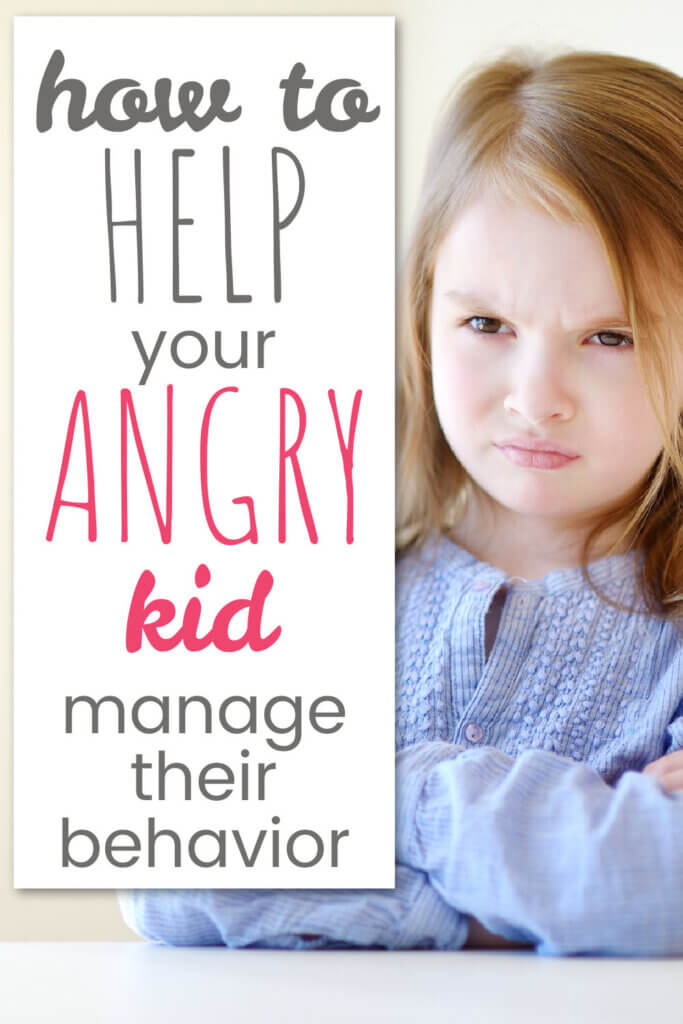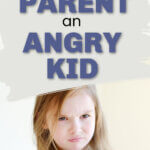Parenting an angry child can be challenging. Anger can be such an intense emotion. You may be concerned about your child’s behavior issues stemming from their anger. Or, you may worry that your angry child has something “wrong” with them. The anger may also be triggering big emotions in you making it hard to be the parent that you want to be.
In order to address anger issues in kids, it is important to find answers to the following four questions:
- Why is my child so angry
- How should I parent my angry child
- How can I help my child manage their anger
- When should I seek professional help for me or my child
What Causes Anger in Children
You may be asking yourself, “Why is my child so angry all the time?” And the truth is that there can be many reasons for a child to be struggling with anger. Let’s look at some of the big reasons why your child may be struggling with anger.
Learning Difficulties
One really common reason for children to struggle with anger is learning troubles. Whether a child has a learning disability such as dyslexia or is just struggling to keep up in math class, they can feel a variety of emotions. Often times kids will feel overwhelmed, frustrated, embarrassed, and confused.
For many kids, it is easier and feels safer to express anger rather than overwhelm, frustration, embarrassment, etc.
ADHD, Sensory Processing Disorders, Autism
Many underlying issues can also cause anger. Kids who have Attention Deficit Hyperactivity Disorder (ADHD) often struggle with impulsiveness and are quick to get angry.
Sensory processing disorders can cause anger over many different things. If a child is feeling overwhelmed because of scratchy pants, they are more likely to have an angry outburst over inconsequential things because all of their tolerance is going towards managing their overwhelmed senses.
Children who are on the Autism spectrum are also often prone to anger. This is especially true anytime routines get disrupted. Autistic kids can also get overwhelmed easily which can lead to big angry meltdownds.
Trauma
Kids who have faced trauma – whether it is through violence, neglect, or abuse, often struggle with anger. Trauma can actually impact the brain by causing disruption in normal emotional development. You will often see kids who have faced severe or long term trauma respond with angry outbursts that seem developmentally much younger than they actually are. For example, a 7-year-old child may throw a tantrum that looks more like a normal 3-year-old style of a tantrum.
Underlying Emotions Like Fear or Sadness
Anger is almost always a cover-up for other emotions. Emotions such as fear, sadness, or even loneliness can make kids feel very vulnerable. Anger helps cover up that vulnerability. It can also provide kids with a false sense of safety in those big emotional moments.
The Managing Emotions Bundle is a great resource for kids who have a lot of emotions underneath their anger. This bundle will help address anger as well as other big emotions like fear.

Life Changes
Going through a transition such as a big move, a divorce, a parent’s illness, or a death in the family can often cause anger in kids. These big life transitions can bring up many different emotions such as fear, sadness, confusion, etc. Anger serves a protective role for kids in these moments. It also is often an easier emotion for kids to express than many of the more complex emotions that come with transitions.
Hormones and Normal Development
Anger is a part of normal child development. Two year old’s often have big tantrums and angry responses as they learn to say no and develop a sense of their own identity.
Going through puberty is another time that anger is very common in kids. For many kids, anger and irritability is often one of the first signs that their hormones are beginning to take over. This is very common in 10-12 year old kids as well as on and off throughout the teenage years.
Unmet Needs
When a kid’s needs aren’t being met, they can often fall into anger. Common needs that will cause anger issues include the need for attention and love from a parental figure and the need for control over their own choices and lives.
Tired, Hungry
It is also important to mention that it is very normal for kids to have trouble with their anger when they are tired or hungry.
Rules for Parenting an Angry Child
If you’re wondering how to deal with your angry child, there are some guidelines that you can follow. These guidelines will help decrease anger over time. They will also give you a plan for dealing with those heated moments.

Don’t respond with anger or yelling
The first important guideline is that it is never helpful to respond to anger with more anger. Adding your own anger to the mix tends to just add fuel to the fire. If you struggle with controlling your own anger, it is important to work on learning calm down skills. Modeling calm responses can be a huge step towards teaching your kids how to manage their own anger.
Reasoning with your child in the heat of the moment won’t work
Another common parenting mistake, when faced with an angry kid, is to try to reason with them. This rarely if ever works. The reason for this is that when kids get angry, their brains basically go offline and they are actually unable to control their thinking and emotions at that moment.
Dr. Dan Siegel has a very helpful explanation of what happens to the brain when it experiences something that triggers a big angry response. He refers to these moments as flipping the lid. This means that the emotional part of our brain that controls big emotions and the fight, flight, or freeze response takes over the thinking, rational part of our brains. Here is a quick video explaining the concept.
Plan for how you will respond ahead of time – identify triggers
Having a plan for how you will respond to your child’s angry responses, tantrums, and outbursts can be really helpful. If your child is struggling with tantrums and you need some ideas on how to manage and stop the tantrums, check out this 5 part series on stopping tantrums.

One of my favorite responses to my child’s anger is to ask, “are you just needing to talk about this or do you need help solving the problem?” This will often defuse an angry rant quickly.
If you are working on making a plan for your response, make sure to also think through what triggers your child’s anger. For example, if they often get angry at bedtime, think through the routine and identify where the anger starts. Then, make a plan to address that moment in a different way.
Stay consistent
Another common problem parents have when faced with an angry, demanding child, is that they start out saying no and then eventually give in and give the child what they are asking for. This lack of consistency actually reinforces your child’s angry response. They learn that if they can just stay angry long enough, you will eventually give in and they will get their way.
Take a break if needed and/or tag team with your spouse
Dealing with an angry child can be exhausting. It is okay to take a break when needed. This is actually a really good way to model a healthier way to deal with anger to your child. You can say something like, “I am feeling really frustrated right now and I don’t want to say or do something I will regret. So, I am going to take 5 minutes in my room to calm down. Then, we can continue this conversation.”
Another option is to tag team with your spouse. Often children will have a bigger anger response with one parent. Having the other parent step in can help calm down the situation and allow you to remain calm and in control of your emotions and behaviors.
Address behavior, not emotion
It is important to remember that anger, in and of itself, is not bad. It is an emotion that serves a very useful purpose. Shaming a child or trying to suppress their anger will eventually back fire. Everyone feels angry at times.
Instead of punishing anger, address the unwanted behaviors that stem from anger. You can be really clear when addressing the behavior by saying something like, “I understand that this situation made you really upset and angry. It’s okay to be angry, but when you started yelling and throwing your toys, your behavior wasn’t safe. I’m going to have you pick up all of the toys you threw to help you remember not to throw things when you are angry.”
Never get physical
Parenting an angry child can lead to a lot of stress and big emotions. It may be tempting for you to spank or get physical with your child when they are angry to try to subdue them.
Using physical force on an angry child can have significant negative impacts. This is especially true when used in the heat of the moment. Using physical violence, including spanking, in these moments, teaches kids that they can use physical violence to deal with their anger.
Model appropriate behavior when angry
The most helpful thing you can do as a parent in regard to anger is to model appropriate behavior yourself. Allow your child to see that you get angry too. But, in the face of anger you take time to calm down, respond rationally, and solve your problems in healthy, calm ways.
Helping Your Child Cope with Anger
There are many different skills and methods you can teach your child to help them learn to control their angry behaviors. Here are some of my go to lessons that I use with angry kids.
Work on identifying anger triggers
A really helpful place to start with kids who struggle with anger is to talk about anger triggers. Anger triggers are the moments, things, people, or situations that tend to initiate an angry response. For example, an anger trigger could be:
- Getting confused in class
- Being told what to do
- Getting hungry
- Loud noises
- Being misunderstood
- Having too much to do
Help your child identify and notice anger warning signs
Another helpful task is to work on identifying your child’s anger warning signs. Warning signs can be:
- Body responses such as clenched fists or a red face
- Thoughts such as thinking bad things about themselves or mean things about others
- Actions such as pacing back and forth or slamming doors
When kids identify their anger warning signs, they are able to recognize that they are getting to a point where they may “flip their lid”. Recognizing these signs become the signal to start using calm down skills.
One helpful way to work on anger warning signs is to use an anger thermometer. I have a free anger thermometer worksheet that you can download in the parenting resource library. You can download this worksheet below.
Use Practical Tools and Worksheets
The Brave Guide to Anger is a workbook for kids that walks them through the process of identifying their triggers and warning signs. It has helpful worksheets that give lots of practical ideas on how to find these triggers and signs and what to do once you find them. You can learn more about the Brave Guide to Anger here.

Work on calm down skills
Calm down skills are a very important part of managing anger. There are different methods of calming down including calming your body through stress relieving activities, becoming more mindful, using distraction, and relieving excess physical energy. Different kids will respond and gravitate towards different calm down skills.
Deep Breathing is an easy way to teach kids to relieve stress and become more mindful. A simple flow of breathe in for the count of 3 then breathe out for the count of 6 works well to relieve physical and mental stress. Wave breathing where you trace a wave pattern on your hand and breathe in as you trace up and breathe out as you trace back down helps to bring awareness and mindfulness to the moment.
If your kids really like deep breathing, these deep breathing posters can be a great resource to hang around the house for subtle reminders to use breathing when they notice their anger warning signs.

Distraction is another great calm down tool. Kids tend to like doing scavenger hunts as a way to distract them. I like doing an ABC scavenger hunt where you look around the room and find something that starts with A, then something that starts with B, and so on. There are some great distraction coping skills included in the Printable Calm Down Cards.
Physical release is another important form of calming down. This can be as simple as taking a walk, doing 10 jumping jacks, or doing a few yoga poses. This article has some great ideas for physical calm down ideas in the face of anger and tantrums.
Make an anger plan together
It can be really helpful to work on a plan for addressing anger with your child. Having them be part of the process of coming up with a plan helps them take responsibility for their actions. It also is more motivating when they are identifying things that they want to do to calm down and manage their anger.
To create a plan, make sure you pick a calm time when your child is not distracted, hungry, or tired. Let them know that you see that they are having a hard time managing their anger and you want to come up with a plan together to help them. Start by asking if they have any ideas. Then, suggest some ideas that they may not have thought of.
Work on communication and problem-solving skills
Often times communication and problem solving are at the heart of anger issues. If a child doesn’t have the skills to solve their own problems, they can easily get frustrated and overwhelmed which can lead to big angry responses.
Similarly, if your child is lacking listening and communicating skills, they may find themselves in situations where others are frustrated with them. This can leave kids feeling confused and vulnerable which can lead to anger as a cover up for their big underlying emotions.
If your child struggles with listening and communication, you may want to look into the Be Heard Method. This is a parenting course that teaches you how to get your kids to listen and comply. Solving listening issues can often be a huge step towards getting rid of overwhelming anger.

When to Seek Help for Your Child’s Anger
While there are many things that you can do at home to help your child address their anger, there are times that you may need some professional help. Needing the help of a therapist or behavioral specialist doesn’t mean that you are a bad parent or that you have failed. Dealing with anger can be a really tough challenge.
Here are some situations that would definitely signal that you may want to get outside help:
If the anger is causing significant behavior issues at school or at home
If your child is having frequent outbursts and behavior problems at school or at home, it may be very helpful to work with a behavioral therapist. They will be able to teach your child how to respond to situations in more appropriate ways.
If your child’s school has a counselor, they are often a good resource for finding the right type of help whether it is a behavioral therapist, a counselor, or something else (such as a learning specialist.)
When anger is causing broken relationships
If your child’s anger is causing a breakdown in their relationships, it is time to get help. Often times kids who struggle with anger will have strained relationships either with their parents, their siblings, or their friends. If their anger has gotten to the point where they are losing friends or their siblings (or you) are not wanting to be near them, then they most likely could use the help of a therapist.
If you are not able to remain calm and consistent with your approach
For many parents, dealing with a child’s anger can be a huge trigger. If this is the case for you and you find it extremely hard to remain calm and consistent, then accessing a therapist can be very helpful. It can also be helpful in these situations to seek additional parenting support such as a parenting class or a support group.
If you suspect the anger may be stemming from an underlying issue such as ADHD, sensory processing disorder, or anxiety
If you are suspecting that your child’s anger may be stemming from an undiagnosed issue, then it is time to start a conversation with your pediatrician. They can help you access the appropriate testing and assessments. Going through this process will also guide you in finding specialists who can help work on the anger given their diagnosis.
Parenting Your Angry Child
Parenting a child who struggles with anger can be quite the process. The good news is that there are many resources that can help both you and your child. Eventually you will find that as your child learns to recognize and calm their anger, their behaviors will decrease and you will land on more steady ground.
You May Also Like
Coping Skills to Calm Angry Kids
How to Discipline a Strong Willed Child
Back Talking in Children



